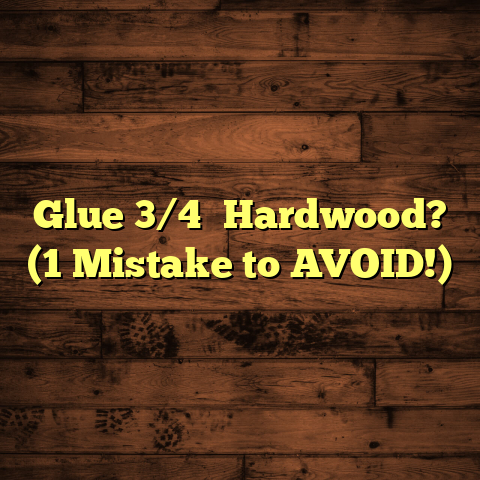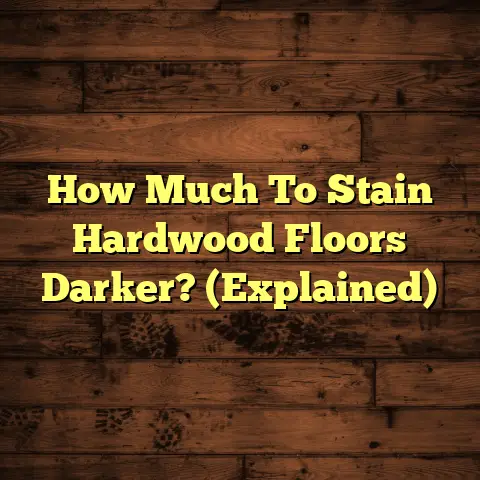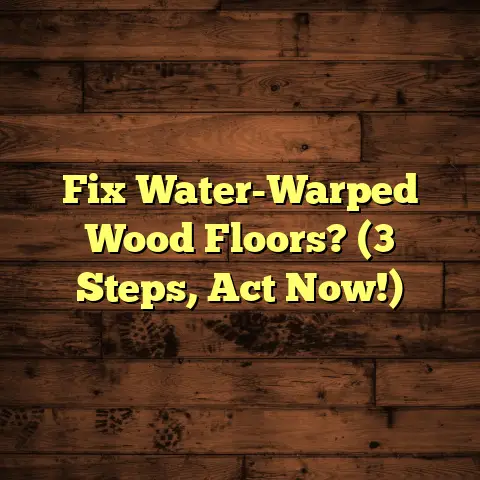Fix Squeaky Floors First! (2 Steps to Silence!)
Imagine this: It’s the dead of night.
The house is quiet, and you’re finally drifting off after a crazy long day.
Creak!
A loud noise cuts through the silence, jolting you awake.
Heart pounding, you lie there wondering, “Was that just my imagination?”
Or is it something… or someone… lurking?
The sound echoes, unsettling you.
What could it be? A ghost? A monster?
Or… just your old, squeaky floors?
Squeaky floors? More like creepy floors, right?
They can turn your home into a source of constant anxiety.
They invade your peace, disrupt family time, and make every step feel like an alarm.
Suddenly, you’re tiptoeing around your own house, dreading the next CREAK.
Sound familiar?
Well, fear not! I’m here to guide you through the unsettling world of squeaky floors.
I’m going to give you a definitive solution in just two simple steps.
Trust me, as a flooring contractor with years of experience, I’ve heard it all.
And I’ve silenced a lot of squeaks.
Let’s dive in and get your home back to being a peaceful sanctuary!
Section 1: Understanding the Problem
What Causes Squeaky Floors?
Okay, let’s get down to the nitty-gritty.
Why do floors squeak in the first place?
Think of it like this: A squeak is just friction screaming for attention.
-
Loose Floorboards: This is the big one.
Over time, the nails or screws holding your floorboards down can loosen.
That allows the boards to rub against each other or the subfloor.
Friction = Squeak. * Inadequate Support: Sometimes, the joists (the beams underneath your floor) are too far apart.
This causes the floor to flex and move when you walk on it, leading to squeaks. * Environmental Factors: Humidity and temperature changes can wreak havoc.
Wood expands and contracts with the seasons.
This can loosen fasteners and create gaps, resulting in… you guessed it… squeaks.
I’ve seen this a lot in older homes. * Subfloor Issues: The subfloor is the layer under your finished floor.
If it’s uneven, damaged, or poorly attached to the joists, it can cause the floor above to squeak.
Think of it like a bad foundation for a house.
It’s going to cause problems down the road.
The Anatomy of a Floor
To really understand the squeak, you need to know what’s under your feet.
Let’s break down the layers:
-
Joists: These are the horizontal beams that provide the main support for your floor.
They’re usually made of wood and spaced at regular intervals.
Think of them as the skeleton of your floor. * Subfloor: This is a layer of plywood or OSB (Oriented Strand Board) that’s attached to the joists.
It provides a smooth, stable surface for your finished flooring. * Underlayment (Optional): Some floors, like laminate or engineered wood, require an underlayment.
This provides cushioning, sound insulation, and moisture protection.
It’s like a comfy blanket for your floor. * Finished Flooring: This is the surface you see and walk on.
It can be hardwood, laminate, carpet, tile, or any other type of flooring.
Now, here’s how different materials contribute to squeaks:
-
Hardwood: Solid hardwood is beautiful, but it’s also susceptible to moisture changes.
When it dries out, it can shrink and create gaps, leading to squeaks. * Laminate: Laminate is more stable than hardwood, but it can still squeak if it’s not properly installed or if the subfloor is uneven. * Carpeted Flooring: Carpet itself doesn’t usually squeak, but the subfloor underneath can.
Also, loose carpet can sometimes create a rubbing sound that sounds like a squeak.
The Impact of Squeaky Floors
Okay, so squeaky floors are annoying.
But are they really that big of a deal?
Honestly, yes. Here’s why:
-
Disrupted Sleep: Let’s be real, nobody wants to be woken up by a creaking floor.
It can seriously mess with your sleep quality. * Stress and Anxiety: Constantly worrying about making noise can be stressful.
It can make you feel like you’re walking on eggshells in your own home. * Reduced Home Value: Squeaky floors can be a major turnoff for potential buyers.
It makes the house feel old and poorly maintained.
According to a 2023 survey by the National Association of Realtors, 68% of buyers said that the flooring condition was important to them.
Squeaky floors can definitely lower your home’s resale value. * Embarrassment: Imagine having guests over and your floors are squeaking with every step.
It’s not exactly the most elegant impression, is it?
I remember one client, Sarah, who was so embarrassed by her squeaky floors.
She told me she would avoid having people over because she didn’t want them to hear the noise.
After I fixed her floors, she said it was like a weight had been lifted off her shoulders.
She could finally enjoy her home without feeling self-conscious.
Section 2: Preparing for the Fix
Gathering Your Tools and Materials
Alright, let’s get practical.
Before you start silencing those squeaks, you need to gather your supplies.
Here’s what you’ll need:
-
Screws: Choose screws that are long enough to go through the floorboard and into the joist, but not so long that they poke through the ceiling below.
I usually recommend 2-inch or 2 1/2-inch screws. * Wood Glue: This will help to further stabilize the floorboards and prevent future squeaks.
Make sure you get a high-quality wood glue that’s designed for flooring. * Drill: You’ll need a drill to create pilot holes and drive in the screws.
A cordless drill is the most convenient. * Drill Bits: You’ll need drill bits that are slightly smaller than the diameter of your screws.
This will prevent the wood from splitting. * Stud Finder (Optional): A stud finder can help you locate the joists underneath your floor.
This will ensure that you’re screwing into solid wood. * Caulk Gun (Optional): A caulk gun is used to apply construction adhesive.
This is useful for gluing down subflooring or squeaky areas that aren’t located on a joist. * Safety Glasses: Protect your eyes from flying debris. * Hearing Protection: Drilling can be loud, so protect your ears with earplugs or earmuffs. * Gloves: Protect your hands from splinters and glue. * Pencil: For marking the location of the squeaks. * Tape Measure: For measuring the distance between joists.
You can find all of these items at your local hardware store or home center.
I recommend investing in quality tools.
They’ll make the job easier and last longer.
Safety First
Before you start any DIY project, safety should always be your top priority.
Here are some precautions to take when fixing squeaky floors:
- Wear Safety Glasses: Protect your eyes from flying debris when drilling or hammering.
- Wear Hearing Protection: Drilling can be loud, so protect your ears with earplugs or earmuffs.
- Wear Gloves: Protect your hands from splinters and glue.
-
Clear the Work Area: Remove any obstacles from the area where you’ll be working.
This will prevent you from tripping or falling. * Be Aware of Electrical Wiring: Before drilling into the floor, make sure you know the location of any electrical wiring.
You don’t want to accidentally drill into a wire and electrocute yourself. * If in doubt, seek professional help. Sometimes it’s best to call in a professional.
Assessing the Situation
Okay, you’ve got your tools and you’re ready to go. But before you start drilling, you need to figure out where the squeaks are coming from.
Here’s how to locate the squeaky spots:
-
Walk Around: The simplest way to find the squeaks is to walk around the room and listen for them.
Pay attention to where the squeaks are the loudest. 2. Pinpoint the Noise: Once you’ve found a squeaky area, try to pinpoint the exact location of the noise.
Sometimes it helps to have someone else walk on the floor while you listen closely. 3. Use a Flashlight: Use a flashlight to inspect the floorboards for any signs of movement or damage.
Look for gaps between the boards, loose nails, or cracks in the wood. 4. Check the Subfloor (If Possible): If you have access to the subfloor from below (e.g., in a basement or crawl space), inspect it for any signs of damage or loose connections. 5. Mark the Spots: Once you’ve located the squeaky spots, mark them with a pencil.
This will help you remember where to focus your efforts.
Pro Tip: Try to identify the type of flooring you have.
This will help you choose the right repair method.
For example, if you have hardwood floors, you’ll need to be careful not to damage the wood when drilling.
Section 3: Step 1 – The Fix
The Floorboard Tightening Method
Alright, let’s get to the first step in silencing those squeaky floors:
Tightening those loose floorboards!
This is often the easiest and most effective way to fix squeaks.
Here’s how to do it:
-
Locate the Loose Board: Identify the specific board that’s causing the squeak.
You should have already done this during the assessment phase. 2. Drill Pilot Holes: Using a drill bit that’s slightly smaller than the diameter of your screws, drill pilot holes through the floorboard and into the joist below.
The pilot holes will prevent the wood from splitting when you drive in the screws. 3. Insert Screws: Insert the screws into the pilot holes and drive them in until they’re snug.
Don’t overtighten the screws, as this could damage the wood. 4. Test for Squeaks: Walk on the floorboard to see if the squeak is gone.
If it’s still squeaking, try adding another screw or two. 5. Countersink the Screws: Use a countersink bit to create a small recess for the screw heads.
This will prevent the screw heads from protruding above the surface of the floor. 6. Fill the Holes (Optional): If you want to hide the screw heads, you can fill the holes with wood filler.
Sand the filler smooth and then stain or paint it to match the color of your floor.
Tips to Avoid Damaging the Wood:
- Use the right size drill bit for the screws.
- Don’t overtighten the screws.
- Use a countersink bit to recess the screw heads.
- If you’re working with hardwood floors, pre-drill the holes.
Using Wood Glue for Additional Support
For extra stability, I always recommend using wood glue in addition to screws.
Here’s how to apply it:
-
Clean the Seams: Use a vacuum cleaner or a damp cloth to clean the seams between the floorboards.
This will help the glue adhere better. 2. Apply Glue: Apply a thin bead of wood glue to the seams between the boards.
You can use a squeeze bottle or a small brush. 3. Press the Boards Together: Press the boards together tightly and hold them in place for a few minutes.
This will allow the glue to bond properly. 4. Wipe Away Excess Glue: Use a damp cloth to wipe away any excess glue that squeezes out of the seams. 5. Allow to Dry: Allow the glue to dry completely before walking on the floor.
The recommended drying time is usually 24 hours.
Case Studies
Let me share a couple of real-life examples of how this method has worked for my clients:
-
Case Study 1: The Old Victorian Home: I had a client with an old Victorian home that had squeaky floors in almost every room.
The squeaks were driving her crazy.
I used the floorboard tightening method with wood glue to secure the loose boards.
The result?
Silence! She was amazed at how quiet her house had become. * Case Study 2: The Laminate Floor: I had another client with a laminate floor that was squeaking in the hallway.
I discovered that the squeaks were caused by an uneven subfloor.
I used shims to level the subfloor and then secured the laminate boards with screws.
The squeaks were gone, and the floor was now smooth and level.
Section 4: Step 2 – The Soundproofing Technique
Adding Soundproofing Materials
Okay, so you’ve tightened the floorboards and applied wood glue.
But what if the squeaks come back?
That’s where soundproofing comes in.
Adding soundproofing materials can help to eliminate future squeaks and reduce overall noise in your home.
Here are some common soundproofing materials:
-
Acoustic Mats: These are thick, dense mats that are designed to absorb sound.
They can be installed under the flooring to reduce noise transmission. * Cork Underlayment: Cork is a natural sound insulator.
It can be used as an underlayment for hardwood, laminate, or tile floors. * Carpet Padding: A thick carpet padding can help to absorb sound and reduce squeaks.
Choose a padding that’s specifically designed for soundproofing. * Soundproof Underlayment: These are underlayments designed to reduce noise.
Installation Process
Here’s how to install soundproofing materials:
-
Prepare the Floor Surface: Remove any existing flooring and clean the subfloor.
Make sure the subfloor is smooth, level, and free of debris. 2. Lay Down the Soundproofing Material: Roll out the soundproofing material and cut it to fit the room.
Overlap the edges of the material by a few inches. 3. Secure the Material: Use construction adhesive or staples to secure the soundproofing material to the subfloor.
Make sure the material is lying flat and smooth. 4. Install New Flooring: Install your new flooring over the soundproofing material.
Follow the manufacturer’s instructions for installation.
Long-Term Benefits
Soundproofing your floors offers a ton of long-term benefits:
-
Reduced Noise: Soundproofing materials can significantly reduce noise transmission between floors.
This is especially beneficial if you live in an apartment or have noisy neighbors. * Increased Privacy: Soundproofing can help to create a more private and peaceful home environment.
You won’t have to worry about your neighbors hearing your conversations or your kids making too much noise. * Improved Comfort: Soundproofing can make your home more comfortable and relaxing.
You’ll be able to enjoy your home without being disturbed by outside noise. * Increased Home Value: Soundproofing can increase the value of your home.
It’s a desirable feature that can attract potential buyers.
I had one client, Mark, who installed soundproofing underlayment when he replaced his floors.
He told me that it made a huge difference in the noise level in his home.
He could no longer hear his neighbors walking around upstairs, and he could finally relax in his living room without being disturbed by outside noise.
Conclusion: Transforming Your Home
So, there you have it!
Two simple steps to silence those squeaky floors!
Addressing squeaky floors promptly and effectively is so important.
It’s not just about getting rid of an annoying noise.
It’s about reclaiming your peace and quiet, reducing stress, and improving the overall quality of your life.
I know it might seem daunting, but trust me, you can do this!
Take the plunge and tackle those squeaks head-on.
With a little effort, you can transform your home into a peaceful sanctuary.
Imagine a home where every step is silent, every room is tranquil, and every moment is filled with peace.
That’s the power of silencing those squeaky floors.
So, what are you waiting for?
Grab your tools, follow these steps, and say goodbye to those annoying squeaks for good!





